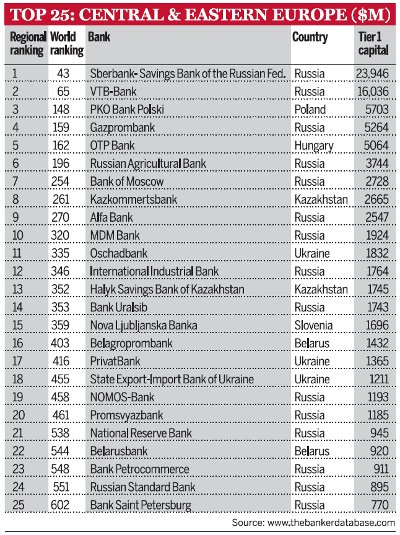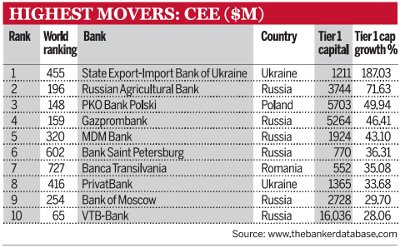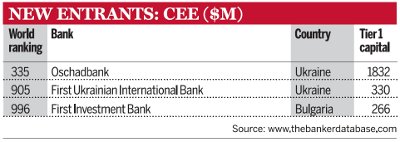Looking at this year's Top 25 central and eastern European (CEE) banks, one could be forgiven for thinking the region's transition to a market economy had gone into reverse.
The largest privately owned bank in the region, Hungary's OTP, slips from three to five, numerous other private banks also slide down the rankings, and almost all the new arrivals in the Top 25 are state-owned, including Ukraine's Oschadbank and State Export-Import Bank (Ukreximbank). In addition, the inclusion of Kazakhstan in this list, omitted last year, sees Kazkommertsbank (KKB) and Halyk Bank take eighth and 13th places, respectively. The Kazakh government took stakes of more than 20% in both banks during the financial crisis.
As a result, the number of banks in the Top 25 that are fully or partially state-owned rises to 12, from eight last year. In many cases, governments have heavily capitalised state-owned banks to pick up the slack as private sector lending is squeezed. But this is not uniformly the case. KKB and Halyk were injected with government capital because non-performing loans (NPLs) in Kazakhstan were soaring as the local real estate market crashed. KKB did not disclose its NPL rate, but Halyk revealed NPLs of 16.7%, placing it among the highest 25 bad loan ratios in the world. The Kazakh sovereign wealth fund Samruk-Kazyna has publicly stated that it aims to sell its shares in the banks by 2012 if possible.
Similarly, the complex story of PKO Bank Polski illustrates the potential conflicts of interest involved in using banks as tools of government policy. The Polish treasury, owning the majority of the bank directly and through another state development bank, and facing a budget deficit of more than 6%, called for a dividend of 40%. The country's banking regulator intervened, arguing that retained earnings should be used to shore up the bank's capital in expectation of higher loan losses. The resulting compromise was the payment of the dividend, and an initial public offering that transferred 48% of ownership to the stock market while increasing PKO's Tier 1 capital by almost 50%.
While it has been a tough year for the private sector in the region, there are some positive stories as well. The merger of Russia's URSA Bank into the MDM brand has propelled the combined MDM Bank from 14 to 10 in the Top 25 CEE rankings, and up 89 places to 320 in the global rankings, making it the second largest privately owned Russian bank after Alfa.
In addition, the tough times have forced private banks in particular to tighten their cost control, leading to some impressively low operating cost-to-income ratios (excluding bad loans). KKB and Russia's International Industrial Bank are both reporting operating cost-to-income ratios among the lowest 10 in the Top 1000.
But there is another important variable on which most banks are not reporting data to the Top 1000 - liquidity ratios. In June 2010, ratings agencies began downgrading Russia's International Industrial Bank on fears that it had insufficient liquid assets to repay an impending Eurobond maturity. We look forward to more disclosure on this vital indicator in future rankings.





